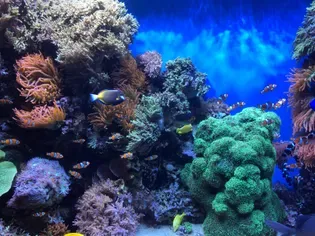How to Maintain a Saltwater Aquarium
Updated on 04/26/24

How to Maintain a Saltwater Aquarium: A Comprehensive Guide to a Thriving Underwater Oasis
Maintaining a saltwater aquarium can be an incredibly rewarding endeavor, bringing the beauty and tranquility of the ocean into your home. However, it requires a solid understanding of the unique needs of marine life and a commitment to providing a stable and healthy environment. This comprehensive guide will empower you with the knowledge and skills to establish and maintain a thriving saltwater aquarium, ensuring the well-being of its inhabitants.
Understanding the Saltwater Aquarium Ecosystem
Before delving into the intricacies of aquarium maintenance, it's essential to comprehend the fundamental principles governing the marine ecosystem you're creating:
* Water Quality: The health of your aquarium hinges on maintaining pristine water conditions. Salinity, pH level, and temperature must be carefully regulated to mirror the natural environment of your marine species.
* Filtration: A robust filtration system is crucial for removing impurities, waste products, and excess nutrients that can harm your aquarium's inhabitants.
* Biological Processes: Beneficial bacteria play a vital role in breaking down harmful substances and converting them into less toxic forms, maintaining a healthy biological balance in your aquarium.
Selecting Compatible Species
Creating a harmonious underwater community is paramount. Choose species that coexist peacefully and originate from similar environments, ensuring their needs are met and reducing the risk of aggression or territorial disputes.
* Beginner-Friendly Fish: Clownfish, damselfish, and firefish are suitable options for novice aquarists, known for their hardiness and vibrant colors.
* Intermediate Species: Angelfish, tangs, and wrasses require more specialized care, including a balanced diet and ample space to swim.
* Advanced Species: Sharks, rays, and larger predators require extensive experience and specialized equipment to maintain their well-being.
Setting Up Your Aquarium
Establishing the foundation for a thriving saltwater aquarium involves careful planning and preparation:
* Aquarium Size: The size of your aquarium will dictate the number and types of species you can accommodate. Start with a tank of at least 30 gallons for beginners.
* Substrate: Choose a substrate that mimics the natural habitat of your selected species. Live sand, crushed coral, or aragonite are suitable options.
* Live Rock: Live rock provides essential hiding places, filtering capabilities, and a base for beneficial bacteria to colonize.
* Lighting: Adequate lighting is vital for photosynthesis, coral growth, and the well-being of your aquarium's inhabitants. Select LED or T5 lighting fixtures that emit the appropriate spectrum and intensity.
Maintaining Water Quality
Preserving pristine water quality is the cornerstone of a healthy saltwater aquarium. Regular testing and adjustments are essential:
* Salinity: Salinity levels between 33-35 ppt (parts per thousand) are ideal for most marine species. Use a hydrometer to measure salinity regularly.
* pH Level: The pH level should be maintained between 8.1-8.4. Monitor pH levels using test kits and make adjustments with pH buffers or additives as needed.
* Temperature: Most marine species thrive in temperatures between 72-78°F (22-26°C). Use a submersible heater to maintain the desired temperature.
* Filtration: Mechanical, chemical, and biological filtration are crucial for removing impurities, debris, and harmful substances. Choose a filter that suits the size of your aquarium and the needs of your species.
* Water Changes: Regular water changes (10-20% every two to four weeks) replenish essential minerals, remove waste products, and prevent the buildup of harmful substances.
Feeding Your Aquarium Inhabitants
Providing a balanced and nutritious diet is essential for the health and vitality of your marine species:
* Live Food: Live brine shrimp, mysis shrimp, and amphipods are excellent sources of essential nutrients for carnivorous species.
* Frozen Food: Frozen brine shrimp, bloodworms, and other invertebrates provide a convenient alternative to live food.
* Dry Food: Specialized pellet or flake food designed for saltwater fish offer a cost-effective and nutritious option.
Monitoring Aquarium Health
Regular observation and testing are crucial for detecting any problems early on:
* Observe Your Fish: Monitor your fish's behavior, appearance, and feeding habits for any signs of illness or distress.
* Test Water Quality: Regularly test water parameters (salinity, pH, ammonia, nitrite, nitrate) to ensure they remain within optimal ranges.
* Inspect Equipment: Regularly inspect your filtration system, heater, and lighting fixtures to ensure they're functioning correctly.
Common Problems and Solutions
Even with meticulous care, saltwater aquariums can encounter occasional problems:
* High Ammonia Levels: Ammonia spikes can occur due to overfeeding, overcrowding, or inadequate filtration. Perform water changes and increase filtration capacity to reduce ammonia levels.
* Algal Blooms: Excessive light, nutrients, or imbalances
Explore More Pets

Freshwater Aquarium Filters
How to Deal With Cloudy Aquarium Water

Saltwater Aquarium Filters
How Do You Remove Chloramines From Tap Water?

Freshwater Aquariums & Habitat
Can I Keep My Koi Fish Inside?

Saltwater Aquariums & Habitat
14 Best Floating Plants for Your Aquarium

Freshwater Fish Health
How to Treat Ich on Freshwater Fish

Saltwater Fish Health
Fin Rot in Aquarium Fish

Freshwater Aquarium Filters
How to Do Aquarium Water Changes

Saltwater Fish Health
How Do Fish Get Parasites?